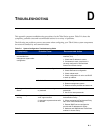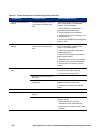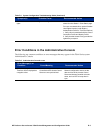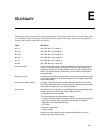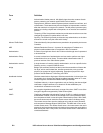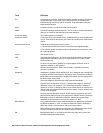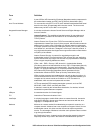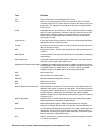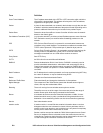Term Definition
AH Authentication Header protocol. AH digitally signs the entire contents of each
packet, protecting your network against three kinds of attacks:
Replay attacks, where an attacker captures packets, saves them until later, and
resends them. These attacks may allow an attacker to impersonate a machine
after that machine's no longer on the network. The AH protocol prevents replay
attacks by including a keyed hash of the packet, so no one else can resend the
packets.
Tampering. IPSec's keyed hash mechanism provide assurance that no one has
changed the contents of a packet after it was sent.
Spoofing. The IPSec AH protocol provides two-way authentication, so the client
and server can both verify the other end's identity.
Allowed Traffic filters Filters that identify client packets that are permitted to be passed by the Access
Controller.
ARP Address Resolution Protocol - A protocol for mapping an IP address to a
physical machine address that is recognized in the local network.
Authentication A means of proving that a client is who it claims to be through use of a password
or shared secret.
Authentication Policy A named, ordered set of authentication services used to perform user logon
authentication for a set of clients. This was called authentication realm in
previous versions of the 700wl Series system.
Authentication service A single instance of a service used for authentication, such as a specific Active
Directory service, or specific RADIUS server.
bridge Bridges (like switches) are devices that control the transmission of data at the
link layer, which controls data flow, handles transmission errors, provides
physical (as opposed to logical) addressing. Examples of popular link layer
protocols include Ethernet, Token Ring, and FDDI.
broadband wireless Wireless transmission at high speed. Wireless transmission is slower than wire-
line speeds; thus, whereas land-based broadband generally starts at T1 rates,
wireless might be considered broadband starting at 250kbps.
CA Certificate Authority - A known organization, such as Verisign, that issues digital
certificates. A digital certificate is an electronic ID that establishes your
credentials in transactions on the Web.
CAST An encryption algorithm that allows for a range of key sizes. CAST is one of the
encryption algorithms supported by 700wl Series system.
CHAP Challenge Handshake Authentication Protocol (CHAP) is a widely-supported
authentication method in which the knowledge of the user's password, rather
than the password itself, is sent during the authentication process. With CHAP,
the remote access server sends the remote access client a challenge string.
The remote access client uses the challenge string and the user's password,
and computes a Message Digest-5 (MD5) hash. The MD5 hash is sent to the
remote access server. The remote access server, who has access to the user's
password, performs the same hash calculation and compares the result with the
hash sent by the client. If they match, the remote access client's credentials are
considered authentic.
E-2 HP ProCurve Secure Access 700wl Series Management and Configuration Guide






